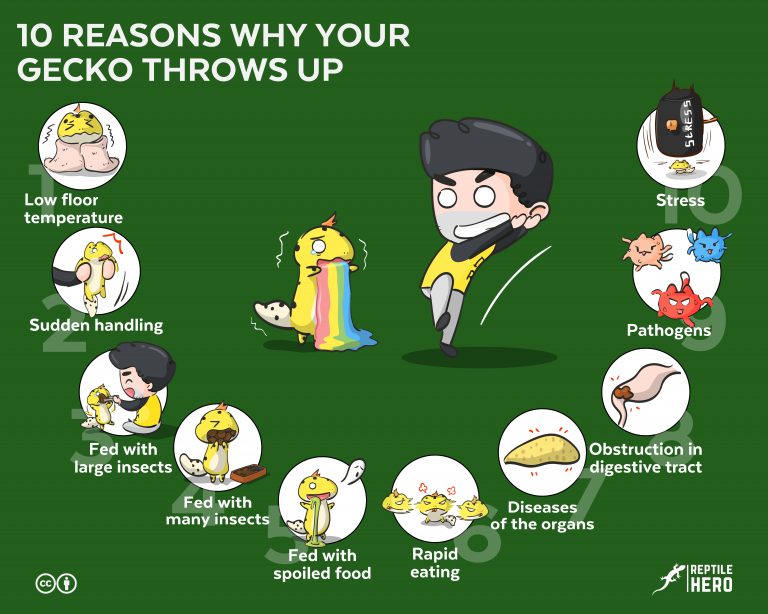Can You Train Your Gecko? [5 Tricks It Can Learn Now]
If you look up “tricks to teach your pet” online, you will probably see videos, articles, and pictures of dogs, cats, birds, or rats. Rarely will you ever see ones on reptiles – why is that?
The overall cognitive abilities of geckos have been greatly underestimated due to biases and lack of research. They can also undergo simple touch, feeder, target-station, leash, and toilet training. However, they are more than capable of completing complex tasks concerned with navigation and memory.
Continue reading to find out what tricks you can teach your geckos to perform.
The Science Behind Training Animals
Let’s start the discussion of getting animals to do tricks by first going through what science has to say.
Characteristics Of Trainable Animals
Professionals from different fields of scientific studies have put in their two cents on animal behavior conditioning. One evolutionary physiologist, in particular, asserts that an animal must meet 6 requirements for it to be domesticated and trained:
- They can’t be picky when it comes to food.
- They should be able to mature much more quickly than humans.
- They must be willing to reproduce even when in captivity.
- They need to be relatively tame and submissive.
- They have to be hard to scare off or alarm.
- They answer to leadership and follow social cues and rules.
According to this theory of domestication, geckos can’t be trained because they fail to meet all criteria. But is this actually true? Well… not really.
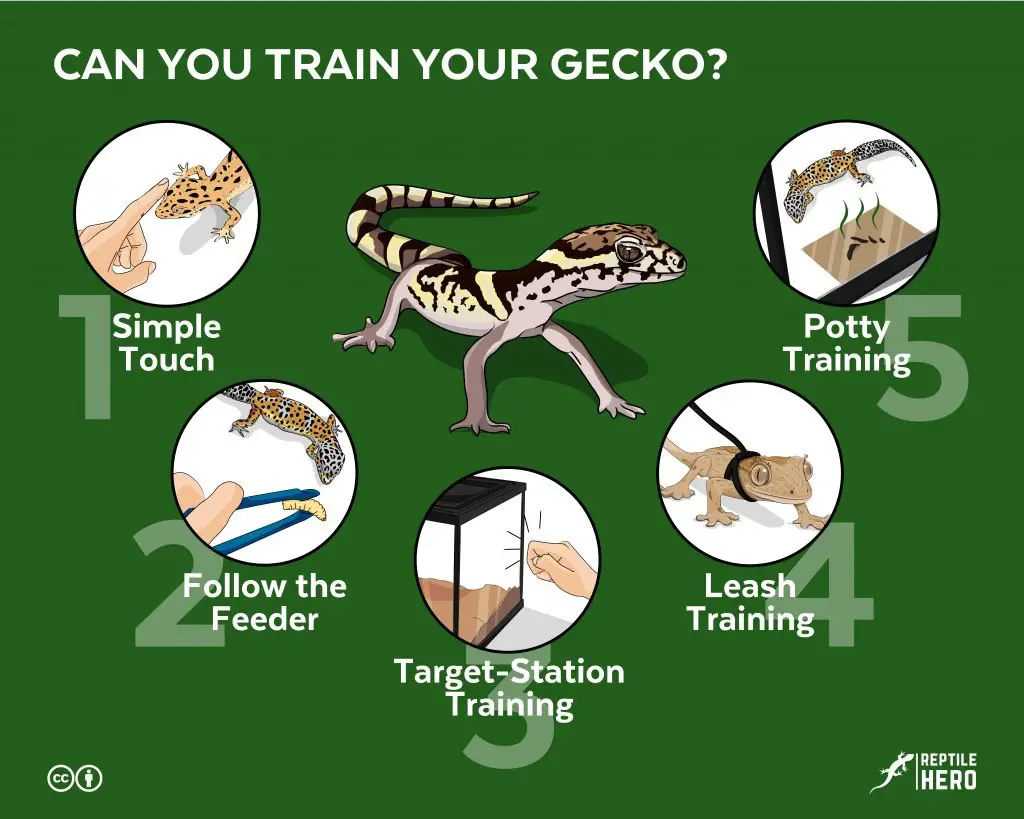
Mammal Brain Vs Lizard Brain
Where did the idea of reptiles being slow and dumb even come from? Well, you can trace it back to the year 1957.
During that time, a physician named Paul MacLean shared his triune brain theory. It detailed his assumptions on how the brain is mainly composed of 3 separate units:
- Human brain – this encompasses the neocortex, responsible for learning, speech, thought, and consciousness;
- Mammal brain – this includes the whole limbic system, in control of emotion, motivation, and memory;
- Lizard brain – this consists of the brain stem, managing reflexes, and instincts
He basically said that the lizard brain is the oldest and most underdeveloped part of our brains. As such, reptiles can never be capable of learning and completing complex actions and tasks. Although it lacks credible proof and actual basis, many embraced the idea that humans are undoubtedly considered the smartest and highest living being on earth. Talk about big egos and narcissism, am I right?
Fast-forward many years later, a famous reptile neuroscientist named Gilles Laurent conducted a landmark study showing the difference in human brains and lizard brains weren’t actually as dramatic as MacLean claimed. As a matter of fact, the parts of their brain were comparable to those of humans’.
Laurent’s findings effectively challenged the notion of lizards being “lower” animals due to their inadequate brains and cognitive abilities. Sadly, many still cling to this idea.
If you still find yourself thinking that there’s some credibility to the triune brain, watch how one keeper showcases his lizard’s intelligence through simple training.
Biases In Research
So let’s talk about the elephant in the room: the bias toward using mammals and birds. Just think about it, even in psychology two of the most famous experiments involve Pavlov’s dog and Skinner’s pigeons.
Well, to be fair, they were a lot easier to handle and source. They were also thought to engage in higher-level learning. Then again, bird-brain is a commonly thrown around insult.
Of course, there has been some research on reptiles even before the lizard brain idea became prevalent. However, most of those used turtles and tortoises – chelonian reptiles. Compared to geckos and other lizards, reptiles that belong to the chelonia order adapt to captivity relatively fast and are not at all hard to feed. And we all know that geckos are fussier than that.
Fortunately, the interest in reptile cognition has been constantly growing in recent years. With the little studies already done, however, we can say that they are much smarter than people have thought. A comparative psychologist does point out that past attempts to explore how reptilian minds operate fail to take into consideration that since mammals and geckos live quite different lifestyles, they are sure to behave differently.
Said studies had crucial flaws in their experimental designs – they were using activities and measures from norms taken from mammals. As such, reptile subjects were doomed to fail from the very start.
More recent researchers – thankfully – factor in stress, acclimation, and humidity and temperature among other things.
In fact, in a specifically modified maze experiment, squamate reptiles – snakes, lizards, and legless lizards – displayed solid evidence of spatial ability and working memory. And after more test runs through the maze, they were able to accomplish their goals much quicker. This just goes to show that they are, indeed, teachable.
Science Says: Yes, You Can Train Geckos
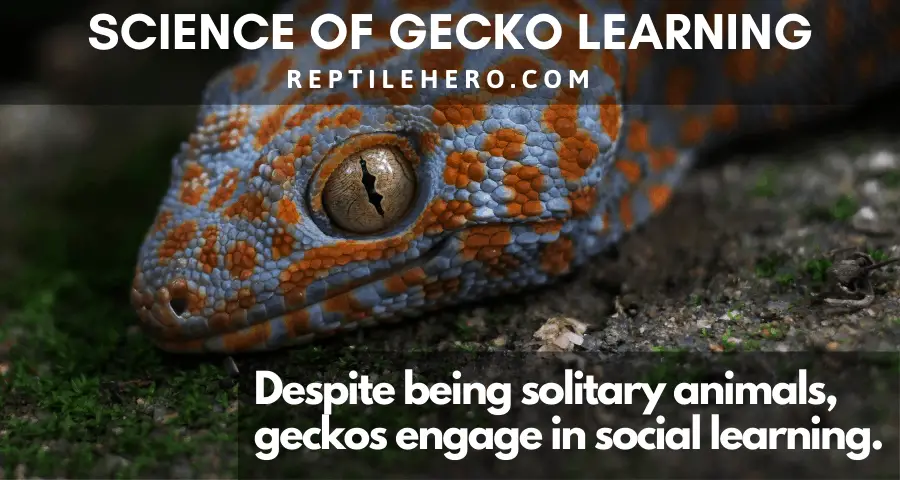
The few studies on the cognitive abilities of reptiles (and geckos are one of them) have provided substantial data to confirm that they are capable of learning, and in turn can be trained to carry out “tricks.”
One study done by researchers from the UK and Hungary showed the capability of reptiles to perform social learning despite being infamous for their territoriality and asociality. It’s noteworthy that the so-called highest form of social learning – imitation – was observed in these supposed low-level animals.
For the experiment, a single lizard was trained as the demonstrator. Its job was to open a door made of wire covering a hole on the wooden board. Upon successfully going to the other side of the doorway, it was rewarded with a mealworm.
After observing how the demonstrator completes the task, all lizards in the experimental group perfectly copied the way the wire door should be opened while none of those in the control group did.
5 Cool Tricks Your Gecko Can Do
Although we now know that reptiles are highly intelligent critters capable of accomplishing pretty complicated tasks, it’s always best to start with simpler things. I mean, you can’t start acting out emotional lines in the theater without knowing or recognizing basic words and tones.
Touch Training
In our eyes, geckos just look like adorable and colorful little creatures. But in their eyes, we might as well be the embodiment of their worst nightmares: gigantic lizard-eating monsters. So yeah, we will most likely never share that much anticipated love-at-first-sight experience.
Don’t feel bad about that, it just comes naturally for them to fear and avoid larger animals as means of self-preservation. So before you even place a single finger on them, ease up a bit and let them slowly get used to you. You can proceed with touch training in this sequence:
- Place a used – but not dirty – piece of garment or cloth with your scent into their enclosure. You know they’ve gotten familiar with your scent once they freely and frequently approach it;
- For the next step, put your hand within the closure – inching closer and closer to the gecko after each session. Of course, you should assess their reactions when it comes to the increasing proximity. Don’t just get close to them out of the blue. Again, once they start coming to you on their own, you can move on to the next step;
- Now you can start touching them bit by bit, don’t swoop in from the top to grab them. If instead of running away from your touch they come up to you willingly, time to move to the last step;
- You know you can start picking them up by the side of their torso, your palm under their belly. Remember that geckos are soft-bodied animals and need careful handling, don’t put too much pressure or grip onto them.
You may need to use woven handling gloves for bigger, more aggressive species like tokays. Be conscious of signs of agitation and fear in geckos as they may nip and bite in defense. Also, your gecko being okay with you handling it doesn’t mean it’s okay with others doing – don’t let people suddenly pick them up.
Follow The Feeder
Another good trick you can do with geckos to get them to open up to you and bond with you is to follow the tong feeder. Yes, I know some may not consider this a trick per se, but it does involve two things from behavior conditioning: action and reward.
There is nothing complicated about this, simply do the following:
- Signal the presence of a treat – fatty feeder insects – with a certain sound when presenting the food to them. The tong you use for this should be the same every single time, not just similar;
- At first, they will only get closer little by little, but as the course of training progresses, they will start to sprint towards the treat. The key here is to only allow them to snatch up the insect once they’ve gone as far as you want them to.
Aside from additional bond time, your gecko gets to work out while running after their treats. This can be done to virtually any gecko species. And if you don’t believe it, watch it for yourself:
Target & Station Training
The main difference between this method and the last one is we are now selecting a specific station for them to go to instead of just racing about spontaneously in or out of their enclosure.
As such the steps involved are similar to the one I gave just before:
- Signal the presence of food – the target – with a certain sound. Tap on their enclosure, use a clicker, or call them by their names. You can do one or two of these;
- On the pathway to your chosen station, present the food as they move closer;
- After a couple of those sessions, limit food reinforcement to only when they are near the station – 5 steps away, then 4, 3, 2, and 1;
- Once that’s successful, call out to them and only give them food once they’re directly at the station.
To make them recognize their food dish as the actual station, repeat the aforementioned steps with the dish located in different parts of the vivarium. You could also try doing this on a maze or DIY obstacle course for more of a challenge.
If target training is used on its own, it could look like the one below.
Leash Training
Surprisingly, experts say that even geckos can be leash trained. But It does come with a number of difficulties as well; they are easy to scare and stress.
To get anywhere close to walking your gecko outside the house, first, do handle training with it. Then replicate the steps but with some revisions and replacements:
- Place a harness into their enclosure. You can rub it around with your palms to make them smell more like you and more familiar to them;
- Then try touching them with the harness and placing them on top of it;
- After that, have them wear the harness. You don’t have to walk them just yet, just let them go about their day as normally as possible while on the leash;
- You can then take them out of their vivarium and walk them around the house. From there, you could slowly let them explore by the door or window to get them comfortable with the outside world safely.
Like in touch training, this could take quite a while – so remember that patience is a virtue. I would like to point out, however, that this is just not for every gecko out there. Don’t force them into a leash if they’re obviously against it. And if they like it, you’ll see just how happy they can get being able to bask under the sun.
Potty Training
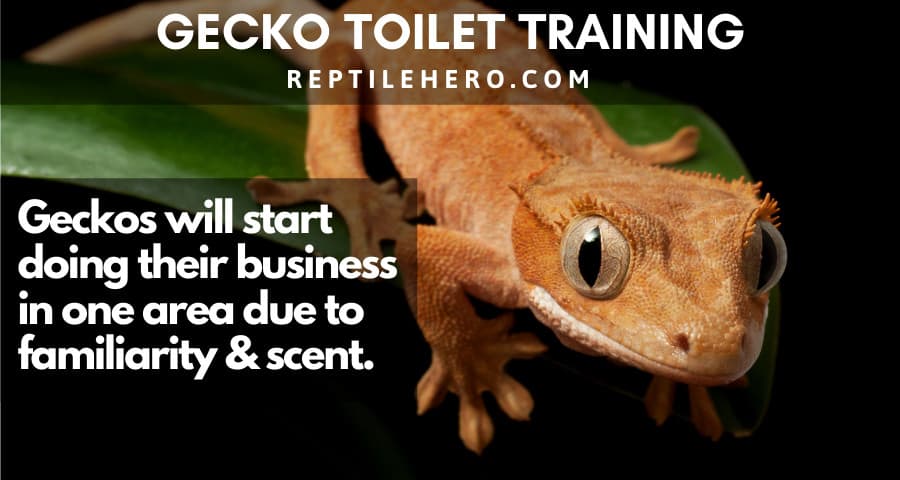
Though most animals recognize where they usually go to do their business, some geckos are just messy party poopers. Of course, having to constantly clean and disinfect your substrate and tank, as a result, can be quite annoying.
So to train him into going to a specific place as a toilet, do all these:
- Observe where your geckos poop over the course of a few days. Pick out a single area it goes to the most when relieving itself;
- Place a piece of paper towel on that area and place the dry droppings on top of it. Replace it as needed. Your gecko will start to get familiar with the scent and associate it with a toilet;
- Once it has started only doing its business on the paper towel, you can slowly try to move it to a better area – somewhere slightly shaded but easy to access would be a good pick.
Takeaways
- Reptiles, in general, are smart animals but they were labeled as dumb critters simply because of biases and lack of proper research.
- Geckos can be trained to get comfortable with handling, follow their feeders as if hunting, go to a specific station to catch their target,wander about while on a harness, or make them “go” in one place.



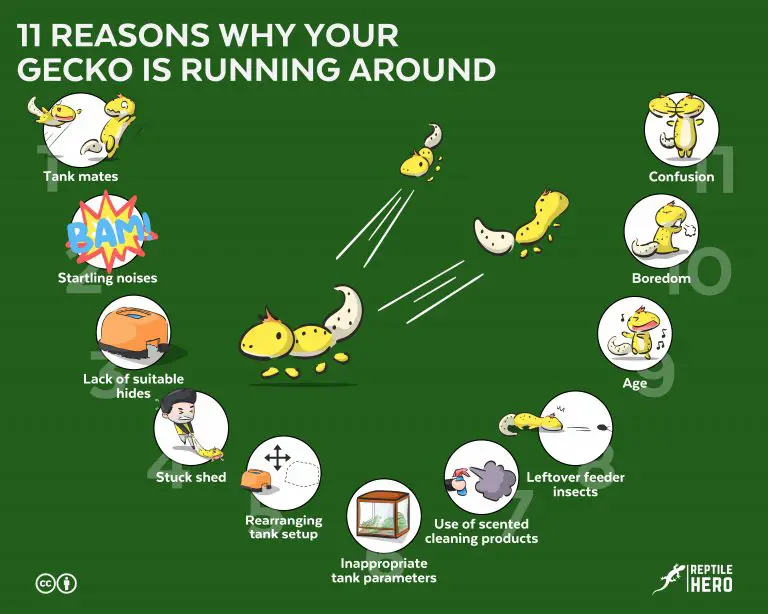
![Why Do Leopard Geckos Poop in the Same Spot? [Wild Nature]](https://www.reptilehero.com/wp-content/uploads/2022/03/why-geckos-poop-in-one-spot-cc-1-768x614.jpg)

